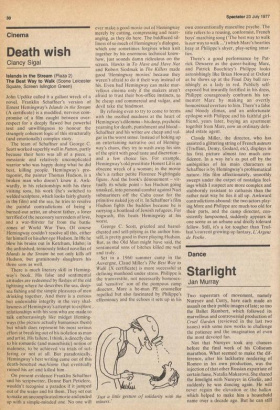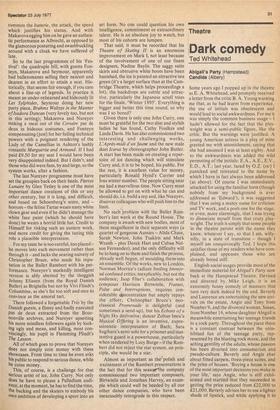Dance
Starlight
Jan Murray
Two superstars of movement, namely Nureyev and Curry, have each made an assault on their public images of late; so too the Ballet Rambert, which followed its marvellous and controversial production of Cruel Garden (reviewed in the last two issues) with some new works to challenge the patience and the imagination' of even the most devoted fan.
Not that Nureyev. took any chances before the final week of his Coliseum marathon. What seemed to make the difference, after . his lacklustre rendering of Romeo in his own production, was the injection of that other Russian expatriate of certain fame, Natalia Makarova. She shared the limelight with Nureyev in Giselle, and suddenly he was dancing again. He will never regain the elevation or the ballon which helped to make him a household name over a decade ago. But he can still
summon the batterie, the attack, the speed which justifies his status. And with Makarova egging him on he gave an authentic performance as Albrecht, as opposed to the glamorous posturing and swashbuckling around with a cloak we have suffered of late, So to the last programmes of his 'Festival': the quadruple bill, with guests Fonteyn, Makarova and Seymour, apparently had balletomanes selling their nearest and dearest in an effort to attain a seat, Historically, that seems fair enough, if you care about a line-up of legends. In practice it meant an under-rehearsed and hideously lit Les Sylphides, Seymour doing her new party piece, Brahms Waltzes in the Manner of Isadora Duncan (very lovely too, but not in this setting); Makarova and Nureyev making a meal out of the Corsaire pas de deux in hideous costumes, and Fonteyn compensating (just) for her failing technical powers with a poignant rendering of the Lady of the Camellias in Ashton's lushly romantic Marguerite and Armand. If I had paid £9.50 for my seat I would have been very disappointed indeed. But I didn't, and those who did were fans, by and large, so the system works, after a fashion.
The last Nureyev programme must have set the groupies back on their heels. Pierrot Lunaire by Glen Tetley is one of the most important dance creations of this or any other century, but it is long, and difficult, and based on Schoenberg's score, and — horrors — the feline Tartar wears nasty white clown gear and even if he didn't manage the white face paint (which he should have done) he wears a horrid little hat. Credit to Himself for risking such an austere work, and more credit for giving the taxing title role a plausible interpretation.
For my taste he is too careful, too placed — he moves into each movement rather than through it — and lacks the searing naivety of Christopher Bruce, who made his reputation in the Ballet Rambert with his performance. Nureyev's markedly intelligent version is ably abetted by the thuggish Johnny Eliasen (from the Royal Danish Ballet) as Brighella but not by Vivi Flindt's Columbine, as she's far too soft and nice to convince as the amoral tart.
There followed a forgettable Trio by the Danish guests, a flimsy and badly executed pas de deux extracted from the Baurnonville archives, and Nureyev upsetting his more mindless followers again by looking ugly and mean, and killing, most convincingly, his pupil in Flemming Flindt's The Lesson.
All of which goes to prove that Nureyev does not simply coin money with these Showcases. From time to time he even asks his public to respond to serious dance, while he coins money.
This, of course, is a challenge for that serious artist of ice, John Curry. Not only does he have to please a Palladium audience, at the moment, he has to find the time, the backing and the skaters to embody his own ambition of developing a sport into an art form. No one could question his own intelligence, commitment or extraordinary talent. He is an absolute joy to watch, but most of his cohorts are lumpen.
That said, it must be recorded that his Theatre of Skating II is an enormous improvement on Mark I, not least because of the involvement of one of our finest designers, Nadine Baylis. The saggy satin skirts and obtrusive white boots have been banished, the ice is painted an attractive sea green (it's a larger surface than at the Cambridge Theatre, which helps proceedings a lot), the backdrops are subtle and attractive, particularly the Japanese scroll trees for the finale, 'Winter 1895'. Everything is bigger and better this time round, so why was I so bored?
Given there is only one John Curry, one must be grateful for the two slim and stylish ladies he has found, Cathy Foulkes and Linda Davis. He has also commissioned two interesting and challenging works, L'Apres-midi d'un Pune and the new male duet Icarus by choreographer John Butler. A start has been made on creating a repertoire of ice dancing which will stimulate Curry and, it is to be hoped, his public, For the rest, it is excellent value for money, particularly Ronald Hynd's Currier and Ives winter number. The people sitting near me had a marvellous time. Now Curry must be allowed to get on with what he can and should do, i.e. build a rep and, like Nureyev, discover colleagues who will push him to the limit.
No such problem with the Ballet Rambert's last week at the Round House. The company is awash with new bodies, most of them magnificent in their separate ways (a quartet of gorgeous Aussies — Alida Chase, Sarah Newton, John Tsakiris and Mark Wraith — plus Derek Hart and Cuban Nelson Fernandez), and the only difficulty will be to hang on to them and finish the process, already well begun, of moulding them-into an ensemble. Of the works, new to London, Norman Morrice's radiant Smiling Immortal confused critics, inexplicably, but not the audience; Jaap Flier's collaboration with composer Harrison Birtwistle, Frames, Pulse and Interruptions, requires considerable glancentration but amply repays the effort; Christopher Bruce's neoclassical Promenade is delightful (and sometimes a send-up), but his Echoes of a Night Sky derivative; dancer Zoltan lime's Musical Offering is an inventive, expressionistic interpretation of Bach; Sara Sugihara's semi-solo for a prisoner and inattentive guard is a powerhouse, particularly when rendered by Lucy Burge — if the Rambert did not reject the star system, on principle, she would be a star.
Almost as important as thel polish and excitement of the Rambert presentations is the fact that for this seasoethe company commissioned two important composers, Birtwistle and Jonathan Harvey, an example which could well be heeded by all our other dance companies, who have been inexcusably retrograde in this respect.







































 Previous page
Previous page